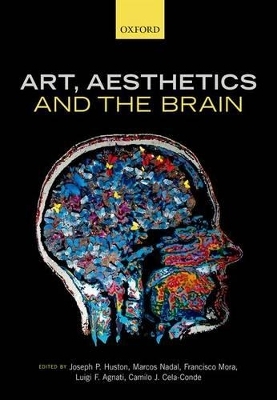
Art, Aesthetics, and the Brain
Oxford University Press (Verlag)
978-0-19-967000-0 (ISBN)
Humans have engaged in artistic and aesthetic activities since the appearance of our species. Our ancestors have decorated their bodies, tools, and utensils for over 100,000 years. The expression of meaning using color, line, sound, rhythm, or movement, among other means, constitutes a fundamental aspect of our species' biological and cultural heritage. Art and aesthetics, therefore, contribute to our species identity and distinguish it from its living and extinct relatives.
Science is faced with the challenge of explaining the natural foundations of such a unique trait, and the way cultural processes nurture it into magnificent expressions, historically and ethnically unique. How does the human brain bring about these sorts of behaviors? What neural processes underlie the appreciation of painting, music, and dance? How does training modulate these processes? How are they impaired by brain lesions and neurodegenerative diseases? How did such neural underpinnings evolve? Are humans the only species capable of aesthetic appreciation, or are other species endowed with the rudiments of this capacity?
This volume brings together the work on such questions by leading experts in genetics, psychology, neuroimaging, neuropsychology, art history, and philosophy. It sets the stage for a cognitive neuroscience of art and aesthetics, understood in the broadest possible terms. With sections on visual art, dance, music, neuropsychology, and evolution, the breadth of this volume's scope reflects the richness and variety of topics and methods currently used today by scientists to understand the way our brain endows us with the faculty to produce and appreciate art and aesthetics.
Joseph P. Huston is Professor of Physiological Psychology at the University of Düsseldorf, Germany. He obtained his PhD in Experimental Psychology at Tufts University, Boston. Was National Academy of Sciences - Czechoslovak Academy of Sciences exchange scientist at the Institute of Physiology in Prague, then at the Institute of Pharmacology, University of Zürich. He has published more than 400 books and scientific articles in areas of behavioral neurosciences with focus on brain mechanisms of addiction, memory and reward animal models of neuropsychiatric and degenerative diseases. He is chief editor of the journals Behavioural Brain Research (Elsevier) and Reviews in the Neurosciences (Degruyter) and the book series Handbook of Behavioral Neuroscience (Elsevier). Marcos Nadal obtained his degree in Psychology at the University of the Balearic Islands, and his PhD in Humanities and Social Sciences (Human Cognition and Evolution Program) (2007). He has been employed at the Department of Psychology of the University of the Balearic Islands since 2004, and occupied a lecturing position from 2010 to 2012. Since then he has been Assistant Professor at the Department of Basic Psychological Research and Research Methods of the University of Vienna. Since their creation in 2001 he has been a member of the Laboratory of Human Systematics and the Human Evolution and Cognition research group. The main objective of that group was the advancement of our understanding of distinctively human cognitive traits. Marcos Nadal's main research has centered on the evolution, the neural correlates and function of cognitive and affective processes involved in aesthetic preference and art appreciation, as well as moral judgment and metaphoric language. Francisco Mora is Doctor of Medicine (1972, University of Granada, Spain) and Doctor of Philosophy (Neuroscience) (1977, University of Oxford, UK). He is professor of Human Physiology at the Faculty of Medicine, University Complutense of Madrid, Spain and adjunct professor at the Department of Molecular Physiology and Biophysics, Carver College of Medicine, University of Iowa, USA. He has written numerous articles for scientific journals including Science and Nature and several books among them The hot brain, MIT Press (2000) Neurocultura, Alianza Editorial (2007) and Neuroeducación, Alianza Editorial (2013). He has received a Helen C. Levitt Professorship Award of the University of Iowa, USA in 2011. He is currently a member of the "Common Room " of the Wolfson College, University of Oxford (2009- ). His field of research is related to the Neurobiological Basis of Aging. Luigi F. Agnati is Professor of Human Physiology at University of Modena, Italy. He currently holds degrees in Medicine, Pharmacy, and Statistics as well as post-graduate specializations in Electronic Calculus (CNUCE, Pisa, Italy), Clinical Neurology (University of Bologna, Italy) and an honoris causa degree from the Karolinska Institutet, Sweden. Luigi F. Agnati has published more than 620 papers in refereed international journals and seven textbooks. He has been a member of the Italian Society of Physiology, Italian Society of Pharmacology, Italian Society of Endocrinology, Italian Society of Neuroscience, Italian Association for the study of pain, European Society of Neuroscience, and European Society of Neuroendocrinology. Camilo Cela-Conde is professor of Anthropology at the University of Balearic Islands, Spain. He received his PhD in philosophy from the Barcelona University, Spain. He has been visiting professor at the University of California, Davis, USA, Universidad Autonoma Metropolitana, Iztapalapa, Mexico, Amazonica University, Belem, Brazil, and Universidad de Bogota, Colombia. He is Fellow of the American Association for the Advancement of Science (AAAS), Section of Biology, USA, Elected in November, 1999, and member of the Center for Academic Research and Teaching in Anthropogeny, Salk Institute and University of California, San Diego, USA, elected in March, 2008. His publications include On Genes, Gods and Tyrants, Springer, Dordrecht, The Netherlands (1989), and Human Evolution. Trails from the Past, New York, Oxford University Press (2007). He is director of the Laboratory of Human Systematics, University of the Balearic Islands, Spain.
SECTION ONE: FOUNDATIONAL ISSUES; SECTION TWO: COGNITIVE NEUROSCIENCE OF VISUAL AESTHETICS AND ART; SECTION THREE: COGNITIVE NEUROSCIENCE OF DANCE; SECTION FOUR: COGNITIVE NEUROSCIENCE OF MUSIC; SECTION FIVE: NEUROPSYCHOLOGY OF ART AND AESTHETICS; SECTION SIX: THE EVOLUTION OF ART, AESTHETICS, AND THE BRAIN; SECTION SEVEN: INTEGRATIVE APPROACHES
| Erscheint lt. Verlag | 16.7.2015 |
|---|---|
| Verlagsort | Oxford |
| Sprache | englisch |
| Maße | 181 x 254 mm |
| Gewicht | 1270 g |
| Themenwelt | Kunst / Musik / Theater ► Allgemeines / Lexika |
| Geisteswissenschaften ► Philosophie | |
| Geisteswissenschaften ► Psychologie ► Allgemeine Psychologie | |
| Geisteswissenschaften ► Psychologie ► Biopsychologie / Neurowissenschaften | |
| Geisteswissenschaften ► Psychologie ► Verhaltenstherapie | |
| Naturwissenschaften ► Biologie ► Zoologie | |
| ISBN-10 | 0-19-967000-5 / 0199670005 |
| ISBN-13 | 978-0-19-967000-0 / 9780199670000 |
| Zustand | Neuware |
| Haben Sie eine Frage zum Produkt? |
aus dem Bereich


